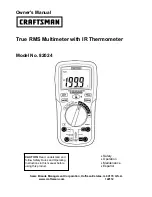
EX503-en-GB_ v5.4 12/15
11
Maintenance
WARNING
: To avoid electric shock, disconnect the test leads from any source of voltage before
removing the back cover or the battery or fuse covers.
WARNING:
To avoid electric shock, do not operate your meter until the battery and fuse covers are
in place and fastened securely.
This MultiMeter is designed to provide years of dependable service, if the following care instructions
are performed:
1.
KEEP THE METER DRY
. If it gets wet, wipe it off.
2.
USE AND STORE THE METER IN NORMAL TEMPERATURES.
Temperature extremes can
shorten the life of the electronic parts and distort or melt plastic parts.
3.
HANDLE THE METER GENTLY AND CAREFULLY.
Dropping it can damage the electronic parts
or the case.
4.
KEEP THE METER CLEAN.
Wipe the case occasionally with a damp cloth. DO NOT use
chemicals, cleaning solvents, or detergents.
5.
USE ONLY FRESH BATTERIES OF THE RECOMMENDED SIZE AND TYPE.
Remove old or
weak batteries so they do not leak and damage the unit.
6.
IF THE METER IS TO BE STORED FOR A LONG PERIOD OF TIME
, the batteries should be
removed to prevent damage to the unit.
BATTERY INSTALLATION
WARNING
: To avoid electric shock, disconnect the test leads from any source of voltage before
removing the battery cover.
1. Turn power off and disconnect the test leads from the meter.
2. Open the rear battery cover by removing two screws (B) using a Phillips head screwdriver.
3. Insert the battery into battery holder, observing the correct polarity.
4. Put the battery cover back in place. Secure with the screws.
Never dispose of used batteries or rechargeable batteries in household waste.
As consumers, users are legally required to take used batteries to appropriate
collection sites, the retail store where the batteries were purchased, or wherever
batteries are sold.
Disposal:
Do not dispose of this instrument in household waste. The user is obligated to take end-of-
life devices to a designated collection point for the disposal of electrical and electronic equipment.
Other Battery Safety Reminders
o
Never dispose of batteries in a fire. Batteries may explode or leak.
o
Never mix battery types. Always install new batteries of the same type.
































